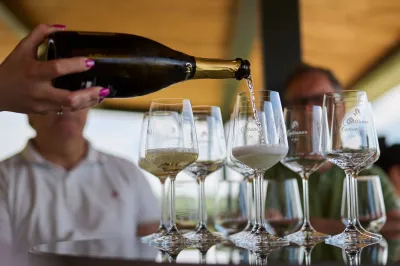Istria
Blessed with hills and a moderate climate modulated by the sea breeze and at least four types of soil (red, white, black and gray soil), Istria is ideal for wine growing. The diverse soils are additionally enriched with limestone deposits in depth, opening up possibilities for the cultivation and production of numerous varieties - red, white and rosé wines, from indigenous and globally distributed varieties, to smaller quantities of sparkling and sweet wines.
Malvasia Istriana
The Istrian eno-icon is the young, fresh Istrian Malvasia, which comprises almost 70% of the production and is the best-loved white wine in Croatia. Istrian Malvasia has a full body and luxurious fruity notes. On the nose you can feel honey, lemon peel, pear, with a nutty, slightly bitter finish.
Teran
Higher positions in central Istria, facing south, are reserved for Teran, another indigenous Istrian variety known and adored for its wild herbal aromas and smoothness. Teran is demanding for cultivation due to pronounced tannins and a high proportion of acids, which, when tamed by the skillful hands of the winemaker, becomes an attractive wine with a medium to strong body, rich in aromas of red fruits, such as sour cherries, sweet cherries, blackberries, with medium and pleasant tannins.
Muscat
Momjan Muscat, produced from a special biotype of the white Muscat variety, which has been cultivated in the area of Momjan for centuries, was declared by the European Union in August 2021 to be the 18th protected designation of origin for wine in Croatia. The name of this wine comes from the small town of Momjan in the north-western part of Istria, where this variety has been grown since ancient times.
You can take in the whole abundant diversity with a glance, from the snow-whiteness of the nearby mountains, the peacefulness of green fields and meadows, plains and valleys, undulating areas with vineyards and olive groves, to the blueness of the endless sea.
Location
The westernmost county of the Republic of Croatia, the largest Adriatic peninsula.
Area
2,820 km2
Number of inhabitants
195,794 (Croatian Bureau of Statistics 2021)
Length of the coast
445 km
Sea
The sea temperature is the lowest in March, when it ranges from 9.3 °C to 11.1 °C, and the highest in August, from 23.3 °C to 24.1 °C. The salinity of the sea averages from 36 to 38 per thousand.
Vegetation
Istria is the largest green oasis of the northern Adriatic. Along the coast and on the islands, pine forests and distinctive green maquis prevail.
The main representatives of the maquis are the holm oak and the Arbutus. Forests in Istria cover 35% of the area.
Administrative center
Pazin (8,638 inhabitants)
Economic center
Pula-Pola (57,460 inhabitants)
Blue Istria
Life along the shores of Istria has always been connected with the sea. Sailors sought refuge in the embrace of its bays, fishermen spent their whole lives worshiping that endless mysterious expanse, and travelers discovered new love in the ports. And they will all agree on one thing - the beauty of the Istrian landscape attracted more than one traveler to stay and start anew... Sail with us along the blue Istrian coasts, follow the sunny path from the east slowly to the west, immersing yourself in the vivid motifs of the Mediterranean expression - bays and beaches, small boats floating peacefully, still waiting in the beauty of solitude.
Green Istria
Istria displayed its wonderful charms in a blossoming Mediterranean garden, on the slopes of the Alps as if on a throne. The Adriatic Sea spread out in front of her like a blue carpet, and jewels lined along the coast: Umag, Novigrad, Poreč, Vrsar, Rovinj, Pula, Rabac... The necklace for which Istria is both known and famous.
However, we invite you to discover its more hidden charms, secret treasures, intimate corners and noble signs. Therefore, come to green Istria, to the regions of dreams and reality that will delight you with beauty and fill you with peace, endow you with antiquities, and invigorate you with that primordial strength that permeates a person when meeting preserved nature and its benefits. The doors of cities and homes will be always open for you. Here they will welcome you with virtue of spirit and offer you the gifts of past centuries.
















































